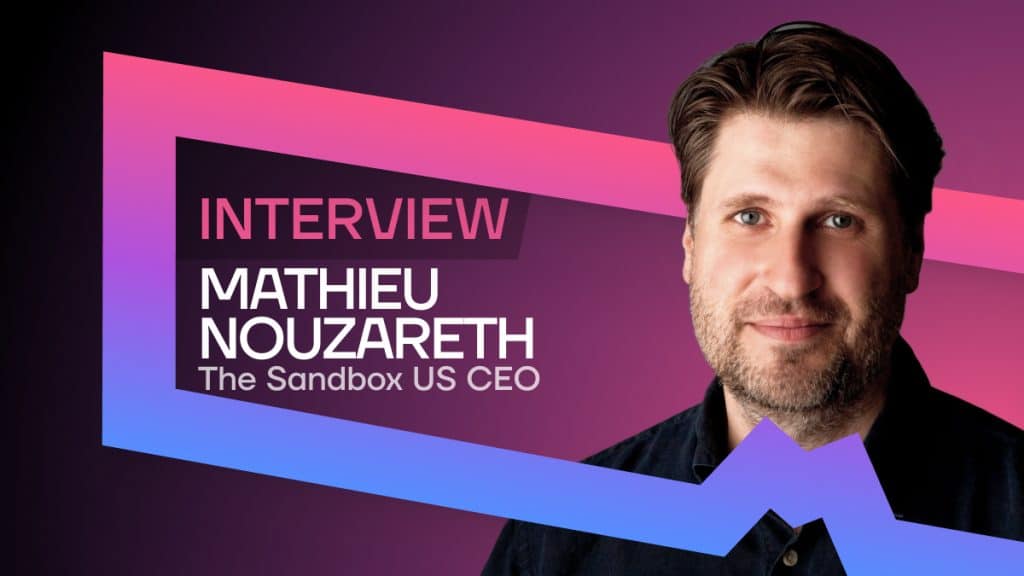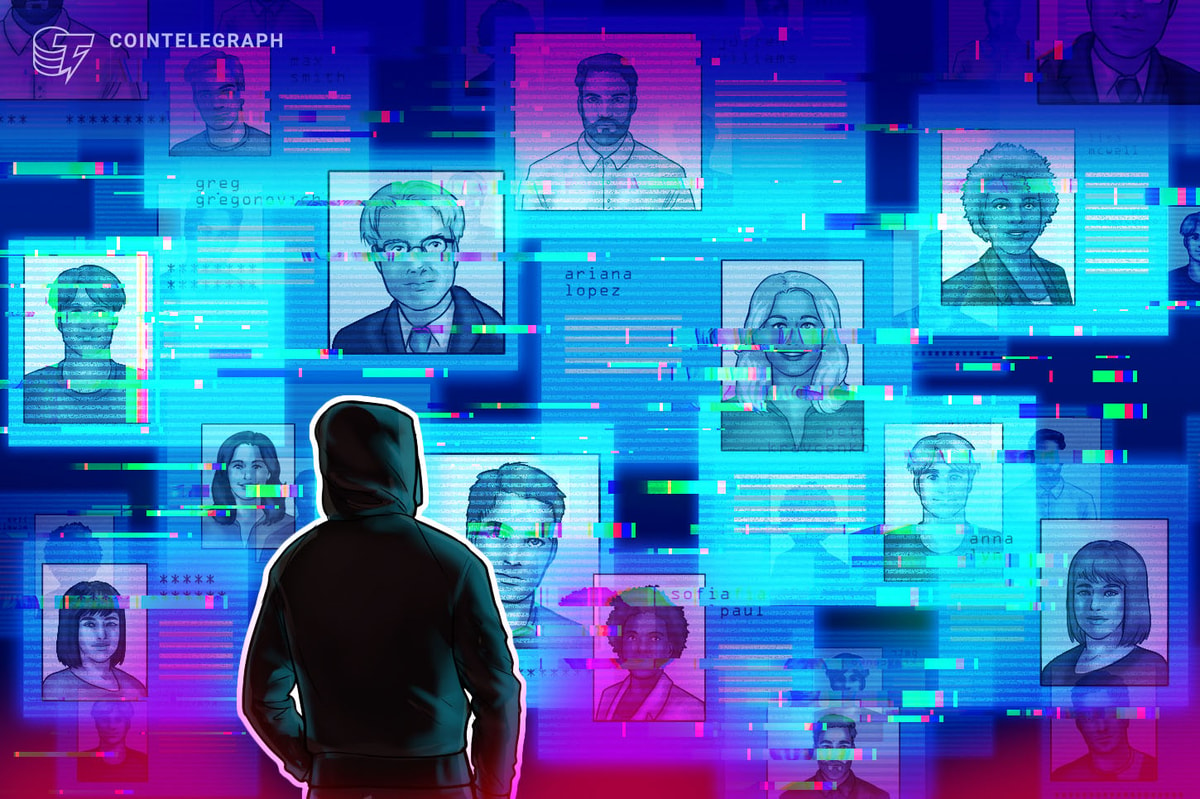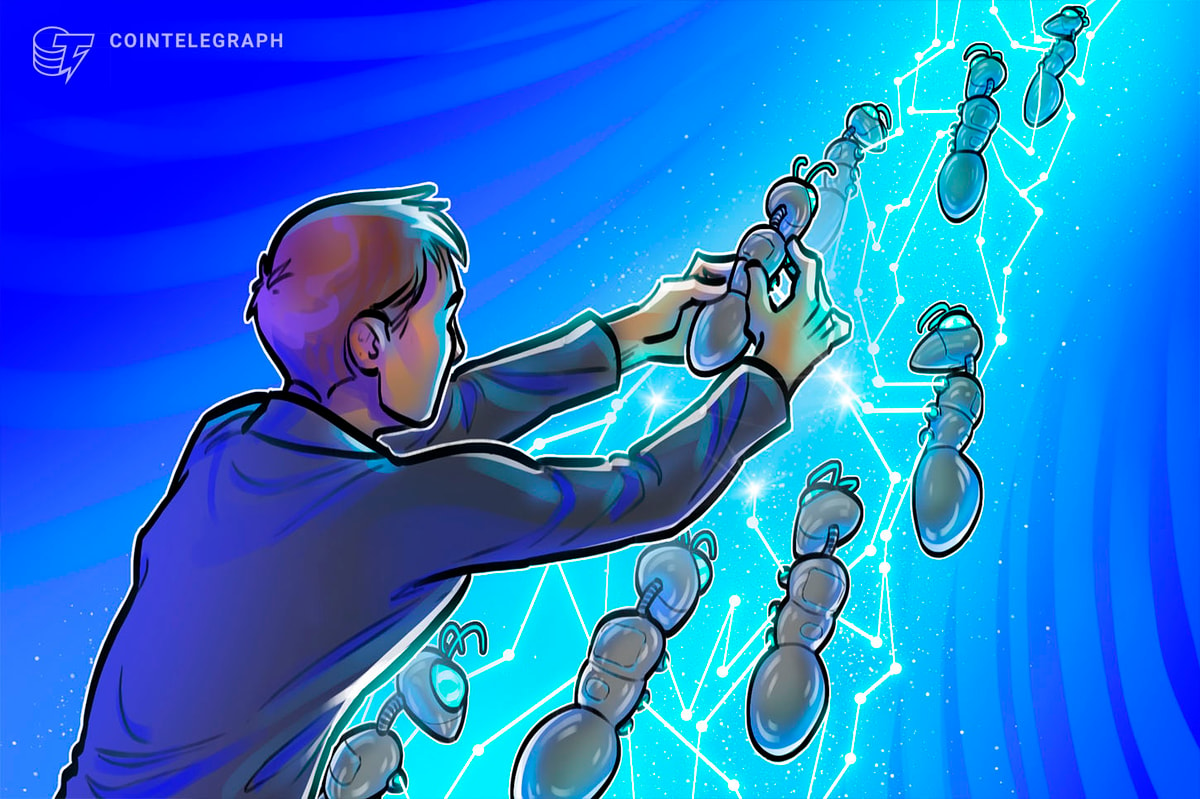
In the metaverse space, The Sandbox has made a name for itself as a pioneer in the field, garnering 1 million unique users over two gaming seasons last year, as well as a number of high-profile partnerships with global companies, entertainment IPs, celebrities, and more.
As the US CEO of The Sandbox, Mathieu Nouzareth has played a key role in guiding the company’s growth and development, supporting the partnerships, client services, and development teams. Before his serial entrepreneurship journey and his role at The Sandbox, Nouzareth co-founded online casual games and social games platforms.
For him, the concept of the metaverse represents a fundamental shift in the way we think about gaming and virtual environments. As he explains, “The concept of the metaverse, where users can interact with each other in a virtual world, has been around for a long time, but it’s only recently that the technology has caught up to make it a viable reality.”
In this interview, we’ll hear from Mathieu Nouzareth about his vision for the future of the gaming industry, the challenges and opportunities presented by the metaverse, and how avatars play a critical role in building a digital identity. From his early days as a gaming executive to his current role as a leader in the metaverse industry, Nouzareth’s insights and expertise offer a unique perspective on the rapidly-evolving world of metaverse gaming.
You came from a web2 gaming background. What was it like to transition to a metaverse gaming platform, and what lessons have you learned from your experience in web2 gaming that you’ve applied to the metaverse?
One of the main lessons we’ve learned from our experience in web2 gaming is the importance of community building. In the metaverse, it’s not just about creating a great game but also about creating a social environment where users can connect with each other. We’ve applied our expertise in fostering a strong community in web2 gaming to the metaverse by creating features like chat rooms, group events, and user-generated content.
Another important lesson we’ve learned is the importance of scalability. In web2 gaming, we could simply add more servers to accommodate increasing traffic. In the metaverse, however, we need to think about scaling in terms of creating a seamless experience for users as they move between different virtual spaces. We’ve invested heavily in building a robust infrastructure to ensure that users can smoothly transition from one area to another without any disruptions.
Finally, we’ve learned that the metaverse is a constantly evolving space, and we need to be adaptable to keep up with the changes. As new technologies emerge and user behaviors shift, we need to be ready to pivot and make changes to our platform. This requires a flexible mindset and a willingness to experiment and iterate.
Can you explain how avatars play a critical role in building a digital identity within the metaverse and how this differs from traditional online identities?
Avatars are the building blocks of the metaverse. As the primary means of interaction between users, they play such a critical role in building a digital identity because they allow users to express themselves and create a unique persona in a virtual world.
Users can customize their avatars with different clothing, hairstyles, accessories, and even body types, allowing them to create a persona that reflects their individuality and personality. Avatars also provide a way for users to physically interact with the virtual environment, from walking and running to dancing and flying.
And avatars are fluid, evolving over time either through additional digital fashion layers or by acquiring a “closet” of skins that can be used for different purposes, platforms, and communities.
In this respect, avatars in the metaverse can serve as a form of social currency, a “flex.” Users with popular or well-designed avatars can gain social status and recognition within the community. This creates an incentive for users to invest time and resources into customizing their avatars and building a unique digital identity.
Another key difference between traditional online identities and avatars in the metaverse is the level of immersion and agency they provide. Avatars allow users to fully immerse themselves in a virtual environment and interact with other users in a more embodied way. This creates a sense of presence and agency that is often lacking in traditional online interactions.
How does The Sandbox approach designing avatars that allow users to express themselves and establish a unique online presence in the metaverse?
Designing avatars in the metaverse requires a focus on customization, diversity, and accessibility.
Customization is critical because it allows users to express themselves and create a unique persona in the virtual world. This can be achieved through a wide range of customization options, from different hairstyles and clothing options to unique accessories and body types. Avatars that offer a high degree of customization are more likely to engage users and keep them coming back to the platform.
Diversity is also essential when designing avatars. Users come from all walks of life and want to be able to represent themselves accurately in the metaverse. A diverse range of customization options, including different skin tones, body types, and facial features, is necessary to ensure that all users feel included and represented.
Accessibility is another crucial factor to consider when designing avatars. The metaverse should be accessible to users with different abilities and disabilities. Avatars should have accessibility features, such as high contrast options and support for screen readers, to ensure that all users can customize and use them effectively.
Microsoft and Disney have recently shifted away from the metaverse, and Meta is now focusing more on AI than the metaverse. Why do you think that is so, and what factors have contributed to this decision? What does this mean for The Sandbox and other companies operating in the space?
We definitely ran before we could crawl when it came to the metaverse. The excitement was real, which inevitably led to the trough of disillusionment. And then the pressures of running a public company amidst macroeconomic headwinds required certain cuts – the metaverse was an obvious place to start since it requires massive investments on a long-term time horizon. And those investments are difficult to make for public companies that answer to investors every quarter.
Disney already has a multiverse with deep lore and passionate fans. That passion creates interesting ways to activate Disney IP: Imagine interactive and responsive Star Wars avatars that use natural language processing to understand and respond to user input, creating a more immersive and engaging experience in both the metaverse and its theme parks. Super fun!
That being said, Disney is missing a critical component of the metaverse: user-generated content. We don’t anticipate that Disney will loosen control of their IPs, which will be a massive hindrance to a true metaverse strategy. We believe in the open metaverse, which benefits users by aligning interests and giving them creative tools to build their own experiences. That’s at odds with Disney’s IP-centric approach – and could prevent other major web2 brands from building their own metaverses.
What impact do you think the development of AI and machine learning will have on how avatars are designed and utilized within the metaverse?
It will have a significant impact, especially when it comes to creators and brands being able to build avatar collections at scale – and even making 1:1 customizations possible.
When it comes to personalizing avatars, generative AI can analyze a user’s behavior and preferences to personalize the avatar to their liking. For example, an AI could analyze a user’s social media activity, search history, or even physical features to create a customized avatar that reflects the user’s identity.
There are also potential benefits when it comes to emotes, which are the way that players express their emotions via avatars. Since machine learning algorithms can analyze vast amounts of data, they could assist AI in generating more realistic facial expressions, body movements, and interactions with the virtual environment.
One exciting area for AI in the metaverse is accessibility. AI and machine learning can help improve the accessibility of avatars for users with different abilities and disabilities. For example, machine learning algorithms could detect and respond to different facial expressions or sign language gestures to create a more inclusive virtual environment. That’s really exciting – and further makes the metaverse an equitable playground for all abilities and backgrounds.
How do you see the concept of digital ownership evolving within the metaverse, and how does The Sandbox plan to address this issue?
The Sandbox is a decentralized gaming metaverse. We use blockchain technology to provide users a secure and transparent ownership system for their digital assets within the metaverse. With this open, transparent and immutable approach, users’ digital assets are protected and tradable with others.
For instance, the Sandbox’s virtual land is divided into parcels, which users can buy, sell, and trade with others. Each parcel is represented as a unique non-fungible token (NFT) on the Ethereum blockchain, which verifies the owner’s ownership of the parcel. Additionally, The Sandbox plans to allow users to create and sell their virtual assets, such as avatars and in-game items, as NFTs on the blockchain. This will enable users to maintain full ownership and control of their digital assets, even if they leave The Sandbox’s platform. And, as we work to build interoperability standards, these assets can have utility outside of a single-walled garden.
Of course, as the metaverse grows and evolves, the concept of digital ownership is likely to become more complex. For example, users may own virtual assets across multiple platforms, and the legal framework around digital ownership and property rights is still evolving. This complexity creates challenges for companies operating in the metaverse, as they need to ensure that users’ digital assets are protected and secure.
Can you discuss any challenges or concerns related to the use of avatars in the metaverse, such as privacy, security, or ethical considerations? How can these challenges be overcome, and how can ethical principles be enforced?
On the privacy side, every social interaction with other avatars can reveal personal information about users, such as their location, activities, and preferences. This information can be used for targeted advertising or other purposes without the user’s consent. Strong privacy policies and data protection measures are ways to address these concerns – as are transparent data disclosures and a business model that avoids monetizing user data for profit.
Security is a concern for all connected platforms, which contend with hackers, phishing attacks, and all kinds of malevolent actors. There are also bullies and offensive behavior that can appear across digital platforms.
To combat these issues, it takes shared standards and cooperation, such as the Open Metaverse Alliance, to drive standards across the metaverse. These alliances can also address ethical considerations, ensuring the fair and equitable treatment of all users who have a right to enjoy a safe space away from abuse.
We also believe in real digital ownership of assets – which may not always be the case with centralized platforms that retain true ownership of any assets held on their platforms. By building standards in collaboration with other platforms, we can ensure that digital ownership rights are preserved, and owners can move their assets freely across platforms.
How does The Sandbox approach the issue of inclusivity and representation when designing avatars for diverse users within the metaverse?
The Sandbox places a strong emphasis on inclusivity and representation when designing avatars. Avatars must be diverse and representative of a broad range of cultures, ethnicities, and backgrounds. This includes providing users with a wide range of customizable features, such as skin tone, hair type, and clothing options, that enable them to create avatars that reflect their identity and culture.
Our partnership with People of Crypto is the best example of this belief that the metaverse should be a place where all users can feel represented and empowered, regardless of their race, gender, ethnicity, or other factors. We launched the PoC avatar collection to promote inclusivity and representation. These avatars are the first-ever customizable avatars that include the ability for holders to express their unique identities across different skin tones, hairstyles, and other traits, including wheelchairs and hijabs, which have actually never been added to avatars previously.
How do you see the role of avatars in the metaverse evolving over the next five to 10 years, and what implications does this have for companies operating in this space?
Avatars are already central to digital identity for players – in Roblox, 20% of players change their avatars every day. They signal affinity to different communities, foster self-expression, and even allow players to experience virtual worlds in ways they could never otherwise – such as a wheelchair-bound person being able to run freely in the metaverse.
Avatars also unlock utility in the metaverse. By owning and playing as a specific avatar, you could unlock new areas of an experience or find other people with similar interests based on which avatars they use.
Customization is also top-of-mind, which provides so many imaginative opportunities for brands. Companies that create compelling and valuable avatar designs and features can monetize these assets through various channels, such as in-game purchases or virtual real estate sales.
Avatars will also continue to play a critical role in facilitating social interaction within the metaverse. As users spend more time in virtual spaces and build relationships with other users, avatars will become even more important for self-expression and social connection.
And some of those social interactions might be augmented by AI, which becomes more sophisticated and capable of performing a wider range of tasks. For example, avatars may be able to act as personal assistants, offering users helpful suggestions and recommendations based on their preferences and behavior.
Do you think government regulation may be necessary to ensure the responsible development and use of avatars within the metaverse? If not, why?
Government regulation, when done thoughtfully, responsibly, and collaboratively, can help provide the foundation for the metaverse to reach its full potential. However, the government still hasn’t managed to put many guardrails on web2 social media platforms, which are often rife with disinformation and abuse – not to mention data privacy issues. With every massive hack, the personal information of millions of people ends up with scammers – who then text us non-stop and try to phish for even more valuable information.
A holistic approach to regulating digital platforms would ensure their responsible development, especially around privacy, security, and ethical considerations. For example, there may be concerns around the collection and use of personal data within the metaverse, as well as issues related to the potential for cybercrime and cyberbullying. Again, these are issues that must be addressed holistically across all digital platforms. Otherwise, we won’t fix anything.
At the same time, there are also arguments against government regulation, particularly if it is overly restrictive or stifles innovation. We need fair, sensible regulations that foster better opportunities for our creators and don’t artificially limit the competitive abilities of anyone.
What do you think about the current state of the metaverse? What kind of role is The Sandbox playing in it?
The metaverse must be a creative place that supports creators with the tools they need to build engaging experiences. That’s been a priority for us since Day One. Since creators, builders, and game studios directly shape the development of the metaverse, we’ve built no-code tools Gamemaker and Vox Edit to empower creators to fully engage and participate in this exciting new frontier. As the metaverse continues to evolve, creators will drive driving innovation, creativity and growth within this dynamic and rapidly expanding space – and each company must exist in service of the creators building the metaverse from the ground up.
Any other metaverse-related industry issue you would like to talk about?
We’re bullish on gaming as a central engagement platform for brands. While the metaverse itself is in its infancy – we have lots of work to do – gaming is not. Thanks to the rise of casual gaming on mobile devices, there are billions of gamers worldwide. This has been a dramatic expansion of audience in a single decade. We believe that we’ll see a similar growth trajectory in the coming years, the macroeconomic environment notwithstanding.
And don’t forget: millions of people are already spending hours per day in the metaverse. It’s not in the future – it’s happening now. And it doesn’t necessarily require bulky VR headsets or expensive devices to access. With existing devices, from smartphones to PC to consoles, there are dozens of open worlds that essentially function as playable metaverses. These immersive virtual worlds are the backbone of the metaverse – and will only improve from here!
Read more:
Read More: mpost.io









 Bitcoin
Bitcoin  Ethereum
Ethereum  Tether
Tether  XRP
XRP  Solana
Solana  USDC
USDC  Dogecoin
Dogecoin  TRON
TRON  Cardano
Cardano  Lido Staked Ether
Lido Staked Ether  Wrapped Bitcoin
Wrapped Bitcoin  Hyperliquid
Hyperliquid  Wrapped stETH
Wrapped stETH  Sui
Sui  Chainlink
Chainlink  Avalanche
Avalanche  Stellar
Stellar  LEO Token
LEO Token  Bitcoin Cash
Bitcoin Cash  Toncoin
Toncoin  Shiba Inu
Shiba Inu  Hedera
Hedera  USDS
USDS  WETH
WETH  Litecoin
Litecoin  Wrapped eETH
Wrapped eETH  Monero
Monero  Polkadot
Polkadot  Binance Bridged USDT (BNB Smart Chain)
Binance Bridged USDT (BNB Smart Chain)  Ethena USDe
Ethena USDe  Bitget Token
Bitget Token  Pepe
Pepe  Pi Network
Pi Network  Coinbase Wrapped BTC
Coinbase Wrapped BTC  WhiteBIT Coin
WhiteBIT Coin  Aave
Aave  Uniswap
Uniswap  Dai
Dai  Bittensor
Bittensor  Ethena Staked USDe
Ethena Staked USDe  Aptos
Aptos  NEAR Protocol
NEAR Protocol  Cronos
Cronos  OKB
OKB  BlackRock USD Institutional Digital Liquidity Fund
BlackRock USD Institutional Digital Liquidity Fund  Jito Staked SOL
Jito Staked SOL  Internet Computer
Internet Computer  Ondo
Ondo  Ethereum Classic
Ethereum Classic